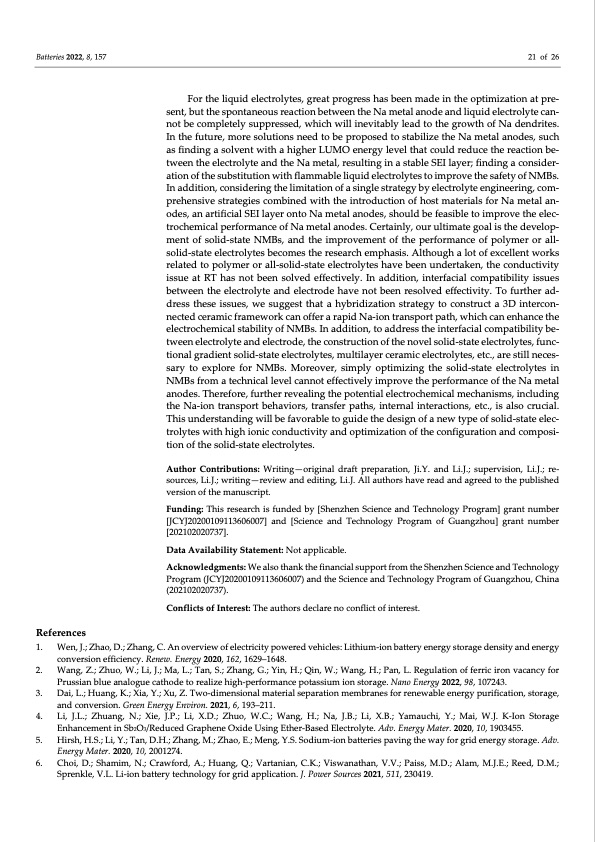
PDF Publication Title:
Text from PDF Page: 021
Batteries 2022, 8, 157 21 of 26 References For the liquid electrolytes, great progress has been made in the optimization at pre‐ sent, but the spontaneous reaction between the Na metal anode and liquid electrolyte can‐ not be completely suppressed, which will inevitably lead to the growth of Na dendrites. In the future, more solutions need to be proposed to stabilize the Na metal anodes, such as finding a solvent with a higher LUMO energy level that could reduce the reaction be‐ tween the electrolyte and the Na metal, resulting in a stable SEI layer; finding a consider‐ ation of the substitution with flammable liquid electrolytes to improve the safety of NMBs. In addition, considering the limitation of a single strategy by electrolyte engineering, com‐ prehensive strategies combined with the introduction of host materials for Na metal an‐ odes, an artificial SEI layer onto Na metal anodes, should be feasible to improve the elec‐ trochemical performance of Na metal anodes. Certainly, our ultimate goal is the develop‐ ment of solid‐state NMBs, and the improvement of the performance of polymer or all‐ solid‐state electrolytes becomes the research emphasis. Although a lot of excellent works related to polymer or all‐solid‐state electrolytes have been undertaken, the conductivity issue at RT has not been solved effectively. In addition, interfacial compatibility issues between the electrolyte and electrode have not been resolved effectivity. To further ad‐ dress these issues, we suggest that a hybridization strategy to construct a 3D intercon‐ nected ceramic framework can offer a rapid Na‐ion transport path, which can enhance the electrochemical stability of NMBs. In addition, to address the interfacial compatibility be‐ tween electrolyte and electrode, the construction of the novel solid‐state electrolytes, func‐ tional gradient solid‐state electrolytes, multilayer ceramic electrolytes, etc., are still neces‐ sary to explore for NMBs. Moreover, simply optimizing the solid‐state electrolytes in NMBs from a technical level cannot effectively improve the performance of the Na metal anodes. Therefore, further revealing the potential electrochemical mechanisms, including the Na‐ion transport behaviors, transfer paths, internal interactions, etc., is also crucial. This understanding will be favorable to guide the design of a new type of solid‐state elec‐ trolytes with high ionic conductivity and optimization of the configuration and composi‐ tion of the solid‐state electrolytes. Author Contributions: Writing—original draft preparation, Ji.Y. and Li.J.; supervision, Li.J.; re‐ sources, Li.J.; writing—review and editing, Li.J. All authors have read and agreed to the published version of the manuscript. Funding: This research is funded by [Shenzhen Science and Technology Program] grant number [JCYJ20200109113606007] and [Science and Technology Program of Guangzhou] grant number [202102020737]. Data Availability Statement: Not applicable. Acknowledgments: We also thank the financial support from the Shenzhen Science and Technology Program (JCYJ20200109113606007) and the Science and Technology Program of Guangzhou, China (202102020737). Conflicts of Interest: The authors declare no conflict of interest. 1. Wen, J.; Zhao, D.; Zhang, C. An overview of electricity powered vehicles: Lithium‐ion battery energy storage density and energy conversion efficiency. Renew. Energy 2020, 162, 1629–1648. 2. Wang, Z.; Zhuo, W.; Li, J.; Ma, L.; Tan, S.; Zhang, G.; Yin, H.; Qin, W.; Wang, H.; Pan, L. Regulation of ferric iron vacancy for Prussian blue analogue cathode to realize high‐performance potassium ion storage. Nano Energy 2022, 98, 107243. 3. Dai, L.; Huang, K.; Xia, Y.; Xu, Z. Two‐dimensional material separation membranes for renewable energy purification, storage, and conversion. Green Energy Environ. 2021, 6, 193–211. 4. Li, J.L.; Zhuang, N.; Xie, J.P.; Li, X.D.; Zhuo, W.C.; Wang, H.; Na, J.B.; Li, X.B.; Yamauchi, Y.; Mai, W.J. K‐Ion Storage Enhancement in Sb2O3/Reduced Graphene Oxide Using Ether‐Based Electrolyte. Adv. Energy Mater. 2020, 10, 1903455. 5. Hirsh, H.S.; Li, Y.; Tan, D.H.; Zhang, M.; Zhao, E.; Meng, Y.S. Sodium‐ion batteries paving the way for grid energy storage. Adv. Energy Mater. 2020, 10, 2001274. 6. Choi, D.; Shamim, N.; Crawford, A.; Huang, Q.; Vartanian, C.K.; Viswanathan, V.V.; Paiss, M.D.; Alam, M.J.E.; Reed, D.M.; Sprenkle, V.L. Li‐ion battery technology for grid application. J. Power Sources 2021, 511, 230419.PDF Image | Electrolyte Engineering for Sodium Metal Batteries

PDF Search Title:
Electrolyte Engineering for Sodium Metal BatteriesOriginal File Name Searched:
batteries-08-00157.pdfDIY PDF Search: Google It | Yahoo | Bing
Product and Development Focus for Salgenx
Redox Flow Battery Technology: With the advent of the new USA tax credits for producing and selling batteries ($35/kW) we are focussing on a simple flow battery using shipping containers as the modular electrolyte storage units with tax credits up to $140,000 per system. Our main focus is on the salt battery. This battery can be used for both thermal and electrical storage applications. We call it the Cogeneration Battery or Cogen Battery. One project is converting salt (brine) based water conditioners to simultaneously produce power. In addition, there are many opportunities to extract Lithium from brine (salt lakes, groundwater, and producer water).Salt water or brine are huge sources for lithium. Most of the worlds lithium is acquired from a brine source. It's even in seawater in a low concentration. Brine is also a byproduct of huge powerplants, which can now use that as an electrolyte and a huge flow battery (which allows storage at the source).We welcome any business and equipment inquiries, as well as licensing our flow battery manufacturing.| CONTACT TEL: 608-238-6001 Email: greg@salgenx.com | RSS | AMP |